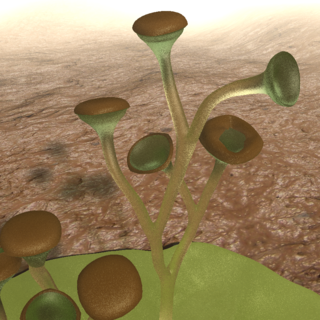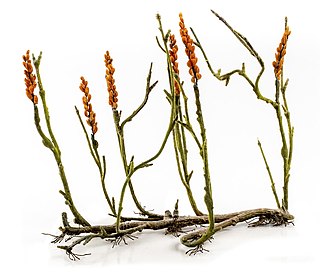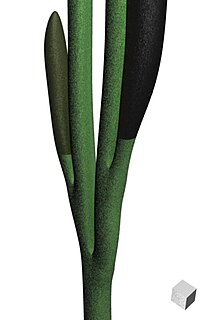
The lycophytes, when broadly circumscribed, are a vascular plant (tracheophyte) subgroup of the kingdom Plantae. They are sometimes placed in a division Lycopodiophyta or Lycophyta or in a subdivision Lycopodiophytina. They are one of the oldest lineages of extant (living) vascular plants; the group contains extinct plants that have been dated from the Silurian. Lycophytes were some of the dominating plant species of the Carboniferous period, and included tree-like species, although extant lycophytes are relatively small plants.

Cooksonia is an extinct group of primitive land plants, treated as a genus, although probably not monophyletic. The earliest Cooksonia date from the middle of the Silurian ; the group continued to be an important component of the flora until the end of the Early Devonian, a total time span of 433 to 393 million years ago. While Cooksonia fossils are distributed globally, most type specimens come from Britain, where they were first discovered in 1937. Cooksonia includes the oldest known plant to have a stem with vascular tissue and is thus a transitional form between the primitive non-vascular bryophytes and the vascular plants.

The zosterophylls are a group of extinct land plants that first appeared in the Silurian period. The taxon was first established by Banks in 1968 as the subdivision Zosterophyllophytina; they have since also been treated as the division Zosterophyllophyta or Zosterophyta and the class or plesion Zosterophyllopsida or Zosteropsida. They were among the first vascular plants in the fossil record, and had a world-wide distribution. They were probably stem-group lycophytes, forming a sister group to the ancestors of the living lycophytes. By the late Silurian a diverse assemblage of species existed, examples of which have been found fossilised in what is now Bathurst Island in Arctic Canada.

The rhyniophytes are a group of extinct early vascular plants that are considered to be similar to the genus Rhynia, found in the Early Devonian. Sources vary in the name and rank used for this group, some treating it as the class Rhyniopsida, others as the subdivision Rhyniophytina or the division Rhyniophyta. The first definition of the group, under the name Rhyniophytina, was by Banks, since when there have been many redefinitions, including by Banks himself. "As a result, the Rhyniophytina have slowly dissolved into a heterogeneous collection of plants ... the group contains only one species on which all authors agree: the type species Rhynia gwynne-vaughanii". When defined very broadly, the group consists of plants with dichotomously branched, naked aerial axes ("stems") with terminal spore-bearing structures (sporangia). The rhyniophytes are considered to be stem group tracheophytes.

Tortilicaulis is a moss-like plant known from fossils recovered from southern Britain, spanning the Silurian-Devonian boundary. Originally recovered from the Downtonian of the Welsh borderlands, Tortilicaulis has since been recovered in the famous Ludlow Lane locality.

Zosterophyllum was a genus of Silurian-Devonian vascular land plants with naked branching axes on which usually kidney-shaped sporangia were arranged in lateral positions. It is the type genus for the group known as zosterophylls, thought to be part of the lineage from which modern lycophytes evolved. More than 20 species have been described.

Polysporangiophytes, also called polysporangiates or formally Polysporangiophyta, are plants in which the spore-bearing generation (sporophyte) has branching stems (axes) that bear sporangia. The name literally means 'many sporangia plant'. The clade includes all land plants (embryophytes) except for the bryophytes whose sporophytes are normally unbranched, even if a few exceptional cases occur. While the definition is independent of the presence of vascular tissue, all living polysporangiophytes also have vascular tissue, i.e., are vascular plants or tracheophytes. Extinct polysporangiophytes are known that have no vascular tissue and so are not tracheophytes.

The Horneophytopsida, informally called horneophytes, are a class of extinct plants which consisted of branched stems without leaves, true roots or vascular tissue, found from the Late Silurian to the Early Devonian. They are the simplest known polysporangiophytes, i.e. plants with sporophytes bearing many spore-forming organs (sporangia) on branched stems. They were formerly classified among the rhyniophytes, but it was later found that some of the original members of the group had simple vascular tissue and others did not. The group has also been treated as the division Horneophyta.
Hostinella is a form genus, used for bare dichotomously branching stems (axes) which have not been found in association with spore-forming organs or sporangia and so cannot be assigned to a more precise genus or species. Specimens assigned to this genus have been found in Bathurst Island, Canada, in the Bertie Formation of Upper Silurian age, where the stems are approximately 1.2 mm in diameter; and in Lower Devonian Senni beds where the axes have a straited external appearance and contain xylem with tracheids.
Uskiella is a genus of small fossil plants of Early Devonian age. The diagnostic characters are naked axes branching isotomously, terminating in ellipsoidal, vertically elongate flat sporangia which split longitudinally into two valves. Spores of U. reticulata have a reticulate appearance. Coalified specimens have been reported from Wales, with a possible occurrence in Australia.
Tarrantia is a form genus of small fossil plants of Early Devonian age. The diagnostic characters are naked parallel-sided axes branching isotomously, terminating in solitary elliptical to ovate sporangia with height greater than width. The relationships of the genus are not clear because many anatomical details remain unknown. It has been treated as a possible rhyniophyte.
Caia is a genus of small fossil plants of Late Silurian age. The diagnostic characters are naked parallel-sided axes branching isotomously, terminating in vertically elongate sporangia which bear spinous emergences particularly at the distal ends. Spores are trilete and retusoid. The only known species is from Hereford, England.

Adoketophyton is a genus of extinct vascular plants of the Early Devonian. The plant was first described in 1977 based on fossil specimens from the Posongchong Formation, Wenshan district, Yunnan, China. These were originally named Zosterophyllum subverticillatum; later the species was transferred to a new genus as Adoketophyton subverticillatum. One cladistic analysis suggested that it is a lycophyte, related to the zosterophylls. Other researchers regard its placement within the vascular plants as uncertain.
Distichophytum is a genus of extinct vascular plants of the Late Silurian (Ludfordian) to Early Devonian (Emsian), around 426 to 393 million years ago. The genus has a tangled taxonomic history, also being known as Bucheria and Rebuchia.
Grisellatheca was a genus of land plant with branching axes. It is known from charcoalified Early Devonian deposits, its type locality being the Brown Clee Hill lagerstatten. Its Terahedraletes spores form permanent tetrads.
Fusitheca was a genus of land plant with branching axes. It is known from charcoalified Early Devonian deposits, its type locality being the Brown Clee Hill lagerstätten. Its spores form smooth-walled, unfused, naked dyads. Its axis comprises length-parallel filaments, and their dichotomies are T-shaped, with the branches bending to continue upwards.
Culullitheca was a genus of land plant with branching axes. It is known from charcoalified Early Devonian deposits, its type locality being the Brown Clee Hill lagerstätten. Its spores formed permanent dyads.
Resilitheca is a genus of land plant known from kidney-shaped sporangia. It is known from charcoalified Early Devonian deposits, its type locality being the Brown Clee Hill lagerstätten. It was listed as a rhyniophyte by Hao and Xue in 2013.
Junggaria was a genus of rhyniophyte-like land plants known from fossils found in China in Upper Silurian strata. It bore leafless dichotomously or pseudomonopodially branching axes, some of which ended in spore-forming organs or sporangia of complex shape. The genus Cooksonella, found in Kazakhstan from deposits of a similar age, is considered to be an illegitimate synonym.
Yarravia is a genus of extinct vascular plants mainly known from fossils found in Victoria, Australia. Originally the rocks in which they were found were considered to be late Silurian in age; more recently they have been found to be Early Devonian. Specimens consist only of incomplete leafless stems, some of which bore groups of spore-forming organs or sporangia which were fused, at least at the base.









